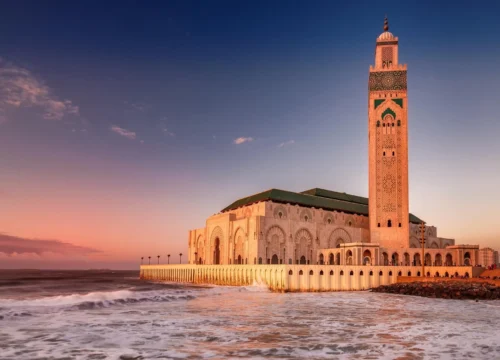Tour Locations: Meknes

About Meknes
With its impressive and historical architecture, Meknes hosts one of the main imperial cities of Morocco, established as a royal capital by Sultan Moulay Ismail in the 17th century. The powerful souks are surrounded by massive walls holding monumental gates, such as Bab Mansour, famous for its fine tilework and grandeur.
Among the important sights are the Royal Stables, which used to accommodate thousands of horses, and the monumental granaries of Heri es-Souani. This historical and architectural value makes Meknes one of the significant centers in the Moroccan past.
Nestled in the heart of Morocco, Meknes stands as a testament to the nation’s rich history and architectural grandeur. Often overshadowed by its more famous counterparts, this imperial city offers a unique blend of historical landmarks, vibrant souks, and a serene atmosphere that beckons travelers seeking an authentic Moroccan experience.
Historical Significance
The Rise of Meknes as an Imperial City
Founded in the 11th century by the Almoravids as a military settlement, Meknes witnessed a transformative era under Sultan Moulay Ismail in the late 17th century. Aspiring to rival the grandeur of Versailles, Moulay Ismail established Meknes as the capital, adorning it with monumental gates, palaces, and mosques.
Moulay Ismail’s Architectural Ambitions
The Sultan’s vision led to the construction of extensive fortifications, comprising walls stretching over 40 kilometers. His reign marked the city’s golden age, leaving behind a legacy of impressive structures that continue to captivate visitors.
Architectural Marvels
Bab Mansour: The Grand Gateway
Completed in 1732, Bab Mansour is celebrated as one of Morocco’s most exquisite gates. Adorned with intricate zellij tilework and Quranic inscriptions, this monumental entrance exemplifies the zenith of Almohad architecture.
Design and Symbolism
The gate’s ornate design features symmetrical patterns and calligraphy, symbolizing the Sultan’s power and the city’s prominence during his reign.
Moulay Ismail Mausoleum
This serene mausoleum serves as the final resting place of Sultan Moulay Ismail. Reflecting traditional Moroccan artistry, the site welcomes visitors to explore its tranquil courtyards and ornate chambers.
Restoration and Accessibility
Recent renovations have preserved the mausoleum’s splendor, making it accessible to non-Muslim visitors who wish to delve into Morocco’s imperial past.
Dar Jamai Museum
Housed in a 19th-century palace, the Dar Jamai Museum offers a glimpse into Moroccan art and culture. Exhibits range from traditional ceramics to textiles, set against the backdrop of Andalusian-style gardens.
Exhibitions and Cultural Insights
The museum’s curated collections provide insights into the region’s artistic heritage, showcasing artifacts that span centuries.
Cultural Experiences
The Bustling Medina
Meknes’ medina, a UNESCO World Heritage site, invites exploration through its narrow alleys lined with shops selling spices, textiles, and crafts. The vibrant atmosphere offers an immersive experience into daily Moroccan life.
Souks and Traditional Crafts
Artisans ply their trades, from weaving to metalwork, offering unique souvenirs and a chance to witness traditional craftsmanship firsthand.
Place El-Hedim
Often likened to Marrakech’s Jemaa el-Fnaa, Place El-Hedim is a lively square where locals and tourists converge. Evening brings storytellers, musicians, and food vendors, creating a dynamic cultural tapestry.
Historical Context
Established during Moulay Ismail’s reign, the square served as a central gathering place and continues to be a focal point of social interaction.
Nearby Attractions
Volubilis: The Ancient Roman City
Located approximately 30 kilometers north of Meknes, the ruins of Volubilis offer a window into ancient Roman civilization. Well-preserved mosaics, basilicas, and arches narrate tales of a bygone era.
Historical Context
As a thriving Roman outpost, Volubilis played a crucial role in regional trade and governance, with remnants reflecting its past prosperity.
Moulay Idriss Zerhoun
Perched atop a hill, the town of Moulay Idriss Zerhoun holds religious significance as the burial place of Moulay Idriss I, the founder of the Idrisid dynasty. Its picturesque white-washed houses and winding streets offer a peaceful retreat.
Pilgrimage and Cultural Importance
The town remains a pilgrimage site, with its annual festival drawing visitors from across the nation to honor its historical and spiritual legacy.
Culinary Delights
Traditional Meknesi Cuisine
Meknes’ culinary scene reflects its rich agricultural surroundings. Dishes often feature olives, citrus, and local grains, with specialties like “tagine” and “pastilla” gracing tables.
Local Markets and Dining Spots
Exploring local markets reveals a plethora of fresh produce and spices, while traditional eateries offer authentic dining experiences that tantalize the palate.
Practical Information
Best Time to Visit
The ideal periods to explore Meknes are during spring (March to May) and autumn (September to November), when the weather is mild and conducive to sightseeing.
Accommodation Options
From traditional riads nestled in the medina to modern hotels offering panoramic city views, Meknes caters to a range of preferences and budgets.
Transportation
Meknes is well-connected by train and bus services. Within the city, taxis and guided tours provide convenient means to navigate its historic sites and attractions.
Conclusion
Meknes seamlessly blends historical grandeur with contemporary Moroccan culture. Its array of architectural wonders, cultural experiences, and proximity to ancient sites make it a compelling destination for travelers seeking to delve deeper into Morocco’s imperial legacy.
Best Tour Locations: Meknes Packages
Explore the Middle East, Unveil its Mysteries!
Ready to cultural tours

The History of Anatolia: Cradle of Civilizations
Anatolia, or otherwise known as Asia Minor, is an enormous region in modern-day Turkey. It has had a very significant impact on world history. Surrounded

Exploring Sultanahmet: The Heart of Istanbul’s Historic Wonders
Sultanahmet is the area that combines the rich cultural and architectural heritage characteristic of the largest city in Turkey, or simply, the historic heart of

Explore Turkey’s Culinary Regions: Black Sea, Aegean, and Mediterranean Food Tours
Join us on a culinary adventure through Turkey’s regions, tasting authentic dishes and learning about the food culture of the Black Sea, Aegean, and Mediterranean.




